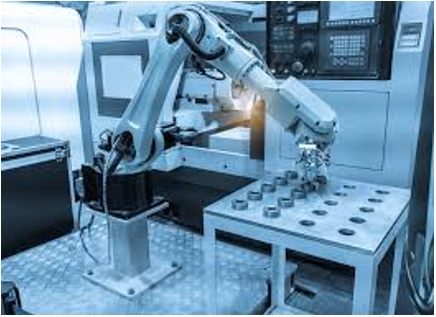INP-WealthPk
Muhammad Luqman
Industrial robots, one of the pillars of the fourth technological revolution, have taken the developed world by storm, significantly enhancing productivity, safety, and time efficiency in various sectors.

Owing to high efficiency and less cost, they are fast replacing human workers in countries like China, Japan, the United States and South Korea. China has the highest number of robots in the world i.e. 783,000 units, followed by 355,000 in Japan. However, in terms of density, South Korea is the world leader with 855 robots against every 10,000 workers, followed by Singapore with 618 robots per 10,000 human workers.
As against these countries, in developing countries automation – especially the use of robots in the industrial sector – is at a minimal level. Pakistan is ranked among the countries with lowest robot density. According to the International Robotics Federation, the number of robots per 10,000 workers in Pakistan stands at just 14. Even these robots, mostly robotic arms, are restricted to automobile, textiles, beverage and auto spart parts units.
According to industrialists, the high cost of robots and unavailability of human resource trained in the robotic operations is a major cause of slow adoption of this technology. “The capital expenditure involved in the use of robots in the industrial units is higher than the return. After the introduction of robots in my factory, the quality of products has improved but the level of production remains unchanged,” said Almas Hyder, a Lahore-based industrialist whose industrial unit is the first factory in Pakistan to have robots.
Almas Hyder, former chairman of the Engineering Development Board (EDB), told WealthPK that another factor that hinders the promotion of robots use in Pakistan is the availability of cheap human labour. “Countries like China, South Korea and Japan have no option but to adopt robotic technology, as the human labour there has gone very expensive over the passage of time,” he explained.
He said there is a need for maintenance shops, spare parts inventory, process developers, designers, operators, engineers, and highly precise front-end and back-end equipment. Over the last decade, the use of robots for service purposes in Pakistan has also been witnessed. The owner of a hotel in Multan introduced a robot waiter and attracted a huge rush, but it could not work for long. Robots have failed to replace the human workforce in Pakistan so far, mainly due to the capital expenditure and availability of cheap labour.
Lately, there have been efforts at the national level to promote robotics in Pakistan. The National Centre of Robotics and Automation is a major example. This is a consortium of 11 labs over 13 universities of Pakistan with its headquarters at the NUST College of E&ME. Though it has been set up as a centre to serve as a leading technological hub in the domain of robotics and automation, it has failed to attract industrialists to turn to robot technology in a big way.
“No doubt, the robotics labs at various universities have started producing the required skilled human resource. But the high price of robots is discouraging its use in the industrial sector,” said Prof. Faizan Irshad, a machine learning expert. He said trained robotic experts are getting jobs abroad due to less opportunities at home. Experts called for local production of low-cost robots to ensure Pakistan can benefit from the fourth industrial revolution, which might otherwise be missed.
Credit: INP-WealthPk




